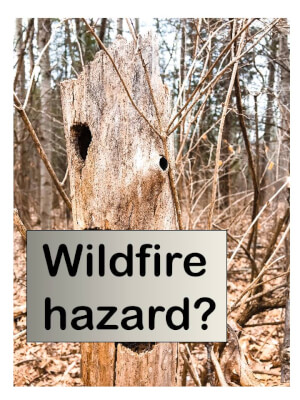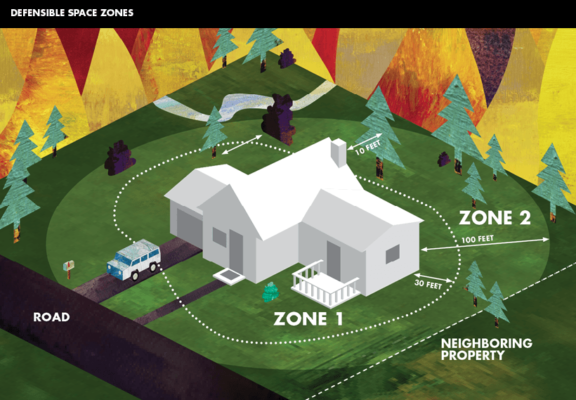 Wildfires are now a year-round threat
Wildfires are now a year-round threat
We used to consider “fire season” to be summer into fall, and then winter rains came along. These days, wildfire season seems to be year round! So we should be taking steps for wildfire prevention year round, too.
Here are 5 Action Items for wildfire prevention. Let’s look at them right now, even while cold January rain is falling outside my window . . .
Wildfire prevention on your own property
I hope that you are pretty familiar with what to do for your own property. Action item #1: Confirm you’re following these basics of wildfire prevention.
1–Maintain defensible space. Maintain an area around the home cleared of brush, dead tree limbs, and flammable plants. In the areas close to your home, chose fire-resistant plants and keep all plants properly irrigated. The image below, showing different defensible zones, comes from the CalFire website: http://www.readyforwildfire.org/Defensible-Space/ .

State law in California requires properties in wildfire areas to maintain a 100 ft. defensible space. In 2015, The Los Angeles’ Brush Clearance Program set more specific – and more stringent — standards for clearance:
- 10 feet of roadways
- 10 feet of combustible fences
- 200 feet of structures
2–Use fire-resistant building materials. Use brick or stone for walls and garden borders. Build decks of noncombustible materials. Re-roofing? Choose fire-retardant shingles. Obviously, you might not be able to make dramatic changes immediately. But at least be aware of changes you should plan for.
3–Block embers. Most fires start from embers that catch on the house, not from a wall of fire! Install screens over vents and block access to eaves and under decks, etc.
This is only a partial list!
I’m in California, where fire danger is particularly high. You may be in a less vulnerable location, or have different issues. So, Action item #2: Check with your own fire department for recommendations or programs for your neighborhood.
For another good overview resource, get this pamphlet from Farmers Insurance. https://www.farmers.com/content/dam/falcon/pdf/catastrophe-brochures/wildfire.pdf
And while we’re on insurance, be aware that your premium may reflect what you’ve done for fire prevention. Some companies may even offer a discount for defensible space and/or fire retardant building.
Action item #3: Talk with your insurance agent about your personal fire insurance coverage.
Wildfire prevention in your neighborhood
It’s one thing to take steps to protect your individual home. After all, by law you are responsible for it.
But what if you live in a neighborhood of closely spaced homes, condos, or in a mobile home park? What about nearby community buildings? Local schools? Parks? If they catch fire, you may be threatened, too.
Action item #4: Find out who is responsible for neighborhood properties. Do they know best practices for fire prevention, and are they following them?
You may need to contact a city or tribal agency, a property manager, or a neighborhood association. Once you have a contact, put on your leadership hat.
Are you on or can you attend a governing board that hires landscapers and/or gardeners? Make sure that your board and the landscapers are aware of basic fire prevention techniques for their site. Do they know what to plant, what to clear, what to trim – and do they do it? (Your fire department will surely be happy to send an expert to one of your board meetings.)
Your own HOA or emergency response team can help individual families understand the safest way to maintain private patios and gardens. Hold a meeting. Draft a notice to include with the rental invoice. Train a couple of your team members as “consultants” for people who have questions or don’t seem to get with the program.
Of course, even with well-maintained defensible space, a property can still burn. But if there’s a choice for fire fighters to protect a prepared space vs. an overgrown and unprepared space, which do you think they will choose?
Consider a community project for wildfire prevention
Since 2013, The National Fire Protection Association® (NFPA) and State Farm Insurance have been sponsoring Wildfire Community Preparedness Day.
This is a national campaign that encourages people to come together ON A SINGLE DAY to reduce wildfire risk. This year, Wildfire Community Preparedness Day is on May 4, 2019.
The idea is to get a group to work together on a project or event. Their efforts may be supported by $500 grants from State Farm.
Here’s what some groups have done in the past:
- 20 volunteers from the Red Cross, AmeriCorps and the tribe prepared a defensible space around the residences of 3 tribal elders in San Diego County.
- The local fire department and a youth organizations spent 3 days clearing out dead trees and underbrush from Colorado Mountain Zoo.
- An elementary school created a “Firewise garden” in front of their school.
- Boy scouts and local residents worked together on a clean-up day, cleaning roofs and gutters, removing vegetation and debris.
- Four towns in Colorado banded together to rent equipment to remove 66 truckloads of slash from home sites!
What about your emergency response group taking the lead on a project?
A community project might be a great way to motivate your group! At the same time you could help promote wildfire safety and strengthen relationships among residents, local fire department, community leaders and elected officials.
To get one of the 150 awards being made by State Farm, you’ll have to submit a plan for your project by March 1.
Action item #5: get all the info about Wildfire Community Preparedness Day, including the application for the grant, at this website: https://www.nfpa.org/Public-Education/Campaigns/National-Wildfire-Community-Preparedness-Day
With the government shutdown still ongoing this week, the whole concept of reducing fire risks seems particularly important. Why? Because thousands of agency employees are not able to do the cleanup and training they would normally be involved in.
Time for us to step up ourselves. Even starting in the rain!
Virginia
Your Emergency Plan Guide team
P.S. This Advisory focuses on preparations you can make BEFORE a fire threatens. Evacuating and fighting fires are separate topics in themselves.
Don't miss a single Advisory.
Thank you for subscribing.
Something went wrong.
